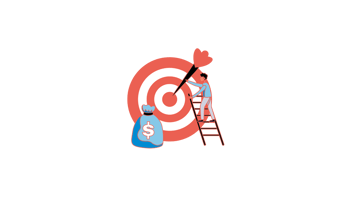Cross-selling and up-selling are becoming two of the more efficient strategies to increase profitability. Do you want to know why?
Cross-selling and up-selling are two types of business intelligence strategies that are becoming increasingly popular among companies. Their growing popularity is due to their proven efficiency in increasing companies' profitability and the average value of the purchase ticket. In fact, these are their aims, but although they can be confused, cross-selling and up-selling are distinct commercial techniques and have different purposes.

What do cross-selling and up-selling mean?
Both strategies are used to boost the income of a company in a simple and low cost way. How? Very simple: increasing the purchase amount of each of our customers. In other words, cross-selling and up-selling are not methods designed to attract new users, but rather to get those who are already our customers to make larger purchases. Additionally, they both work for B2B and B2C indistinctly. Each company must decide, consulting with experts, which of the two typologies would be more convenient for them or whether they should implement both.
Cross-selling
Cross-selling is a commercial strategy that consists of increasing the quantity of products that our clients buy, once they have already got in touch with our brand and have the intention of purchasing. This is achieved by offering them other products that are similar or in some way related to those they already aspire to get. For example, let's imagine that a person goes to a technology store with the intention of buying a laptop. If we know that a large number of customers who buy this product also buy headphones, we will have to offer them. Obviously, cross-selling should not be carried out in a random way and does not consist of offering as many products as we can. On the contrary, this technique is based on the insights we have about our customers. Without data quality, it is impossible for cross-selling to work properly. For the strategy to be effective, we must know our users well. Not only what they buy, but we must also know who they are (gender, age, geographical origin, employment, consumer and leisure habits, hobbies, etc.) when they buy, how much they usually spend, what other products they are interested in, why they buy them... We must also have a broad knowledge of the products we offer.
In short, cross-selling is based on understanding the relationships between our customers and the products or services we provide and, in turn, the relationships that the items have with one another.
Up-selling
On the other hand, up-selling consists in getting customers to end up buying products or services that are more expensive than those they intended to buy. So, in this case, it is not a matter of trying to get users to buy more items, but rather to get them to buy items that serve the same purpose as those they intended to buy, but are more expensive. Referring to the previous example, if a person goes to a store to buy a laptop, through up-selling we will convince them to buy a higher-end computer than the one they intended to buy. As with cross-selling, to achieve this we must understand the links between our products and know our customers.
Both methods start with data analysis, through which we can determine which products we should suggest according to the customer and his or her purchase intention. They are put into practice through intelligent automatic recommendation systems.
Cross-selling and up-selling depending on the type of business you own
When applying these commercial strategies we must take into account the particularities of our business. Mainly, these two techniques are applied differently depending on whether we have a physical store, or we work in e-commerce.
In the first case, we have much less information about our customers so the process of data collection and its transformation into insights will be more laborious. There are multiple ways to do this. For example, we can analyze the purchase tickets or explore KPIs such as the average ticket —looking into both the quantity of products and their value—, the average turnover per customer or the degree of customer satisfaction. Again, it is important to keep in mind that to achieve an optimal diagnosis we must study both the behavior of customers and the connections between our products.
Once we have the necessary information, we can apply cross-selling or up-selling in various ways. In the case of a physical business, we can have customer service employees recommend items, position the products we are interested in selling in strategic places in the store or create offers. As for e-commerce, the application techniques are also multiple. The recommendation of similar or associated products is certainly the most frequent, but there are many others such as retargeting or remarketing, automated advertising, promotion offers, using pop-ups, direct communication with the customer, etc.
The application of up-selling and cross-selling in e-commerce is easier because in the digital ecosystem we automatically have a large amount of data about our users. Knowing who they are, what interests them, what channels they use, what their consumption habits are, etc., is within our reach, although it is essential to understand that for the data to be transformed into reliable and effective insights and information, it is essential that the use, treatment and analysis of the data are appropriate. Again, without quality insights, cross-selling and up-selling will not intensify our profitability.
Why can they do for my company?
These two strategies are very effective and will bring numerous benefits to your company. In addition, their implementation cost is lower than other methods so the ROI is higher.
- Superior sales and income: Both techniques will increase your income, either in number of products sold or in their value. It is estimated that these strategies will make your income grow between 10% and 30%.
- Higher profitability: Enlarging your income through a low investment will significantly increase the profitability of your business.
- Cost optimization: Achieving more profit from those who are already our customers always means less associated costs than reaching new clients. In addition, these methods mean rationalizating those expenses related to management and logistics.
- Adding value: By offering more products to our clients or rising the quality of the ones they acquire, we are expanding the satisfaction of their needs and, therefore, intensifying the added value of our brand.
- Customer retention: Increasing the satisfaction of needs, as well as increasing the quantity and quality of products, results in greater customer loyalty. In fact, it is estimated that both strategies achieve a 5% increase in customer retention.
- Better knowledge about our clients: Cross-selling or up-selling will bring us to know our clients more and better and to obtain higher quality insights that we can later reuse to create other business strategies and to make better decisions.
In short, cross-selling and up-selling are business methodologies that will help you increase your company's total revenue and profitability in a simple, affordable and effective way.
If you want to know more about how you could apply them in your company, please contact us. We will be glad to help you!



